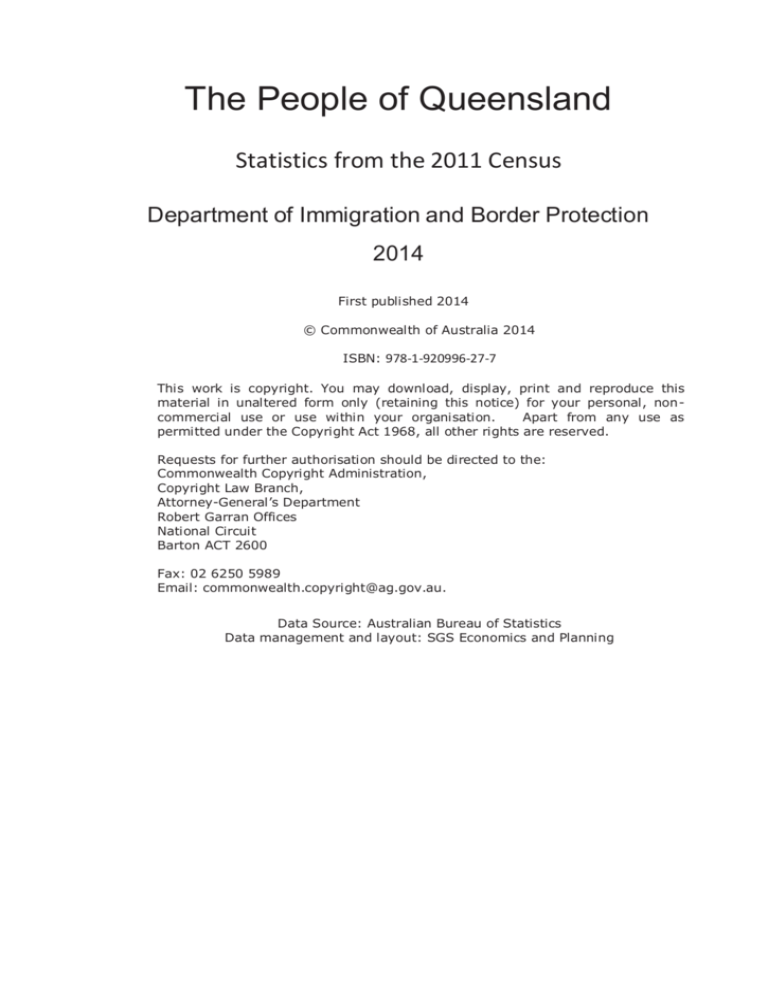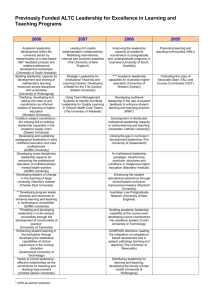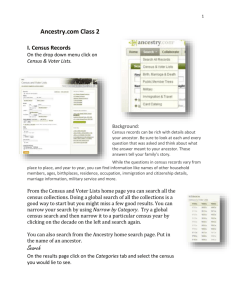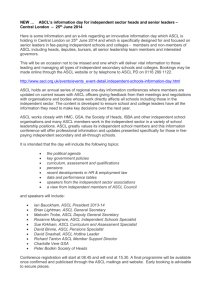
The People of Queensland
Statistics from the 2011 Census
Department of Immigration and Border Protection
2014
First published 2014
© Commonwealth of Australia 2014
ISBN: 978-1-920996-27-7
This work is copyright. You may download, display, print and reproduce this
material in unaltered form only (retaining this notice) for your personal, noncommercial use or use within your organisation.
Apart from any use as
permitted under the Copyright Act 1968, all other rights are reserved.
Requests for further authorisation should be directed to the:
Commonwealth Copyright Administration,
Copyright Law Branch,
Attorney-General’s Department
Robert Garran Offices
National Circuit
Barton ACT 2600
Fax: 02 6250 5989
Email: commonwealth.copyright@ag.gov.au.
Data Source: Australian Bureau of Statistics
Data management and layout: SGS Economics and Planning
Contents
About this publication
How to use this publication
Notes on the Data
Abbreviations and Acronyms
SECTION 4 - 4 Page Profiles of Regional Local Government Areas
Appendix
Map 1
Local Government Areas in Queensland
Map 2
Local Government Areas in Far North Queensland
Map 3
Local Government Areas in West of Far North Queensland
Map 4
Local Government Areas in South East Queensland
Map 5
Statistical Subdivisions in Brisbane
Map 6
Statistical Divisions in Queensland
About this Publication
The People of Queensland is a major compilation of statistics on birthplace, language, religion and ancestry from
the 2011 Census of Population and Housing. This publication has gone to considerable lengths to create a data
source which is unique, accurate, detailed and comprehensive. Some of the features of this publication include:
•
•
•
•
Customised local area tables. The People of Queensland presents ranked lists of birthplace, language
and religion for each Local Government Area (LGA) in Queensland, along with age profiles of selected
birthplace and language groups, and details on ancestry and birthplace of parents for all LGAs. This
gives a very complete picture of the diversity of each area.
Age-gender profiles for the most common birthplace, language and ancestry groups in Queensland
show the diverse structure of our population.
Detailed ancestry data by birthplace of parents, gives a clear picture of the extent of our migrant
communities.
English language competency by age, presenting the differing levels of competency amongst the
various language and age groups.
How to use this Publication
This publication is presented in four sections, covering three broad geographical areas around which the
data is arranged:
•
•
•
•
Section
Section
Section
Section
1 – Australian overview
2 – Queensland overview
3 – South-Eastern Queensland by Local Government Areas
4 – Regional Queensland by Local Government Areas
The first two sections of the publication contain the most detailed data. They present a series of tables and
graphics including:
•
•
•
•
•
A full listing of birthplace, language, religion and ancestry data from the 2011 Census with comparisons
to 2006 where appropriate.
Graphics on the residential patterns of the major birthplace groups.
Special cross-tabulations of language with birthplace, religion with birthplace and ancestry with
birthplace of parents which reveal richer information on the make-up of the ethnic and religious
communities in the State.
Data on English language proficiency by age.
Age-sex histograms on major birthplace, language and ancestry groups.
Sections 3 and 4 are comprised of a series of 4 page profiles containing statistics on birthplace, language,
religion and ancestry for each LGA in Queensland. These profiles can be used to compare different areas in
Queensland – for example identifying the LGA with the highest overseas born population. They can also be
compared against the 4 page profile for QLD at the end of section 2 – for example, whether the proportion of
Italian speakers for a given area is above or below the QLD average.
Notes on the Data
The figures in this publication are based on data from the 2011, 2006 and 2001 Census of Population and
Housing conducted by the Australian Bureau of Statistics (ABS), and are based on usual resident counts, i.e.
counts of where people usually lived at the time of the Census.
Geography
In the summary tables, charts and 4 page profiles presented for Queensland, the geographic level used is 2011
Local Government Areas (LGA). Some of these have changed substantially since 2006 and 2001. Where
amalgamations have occurred the amalgamated data has been presented. When boundaries have changed
due to new LGAs forming or existing LGAs redefining their boundary, 2006 data is presented by aggregating the
constituent Statistical Local Areas (SLAs) or Collection Districts (CDs) of the LGA and 2001 data is not
presented.
Introduced Random Error
Data released by the ABS is subject to randomisation of small cells to maintain confidentiality of
respondents. The following selected text is taken from the ABS 2011 Census Dictionary (further details as
to how and when the introduced random error is used can be found in the glossary of ABS 2011 Census
Dictionary Cat 2901.0):
Care is taken in the specification of tables to minimise the risk of identifying individuals. In addition, a
technique has been developed to randomly adjust cell values. Random adjustment of the data is
considered to be the most satisfactory technique for avoiding the release of identifiable Census data.
When the technique is applied, all cells are slightly adjusted to prevent any identifiable data being
exposed... No reliance should be placed on small cells as they are impacted by random adjustment,
respondent and processing errors.
(Source: ABS 2011 Census dictionary Cat 2901.0)
The effect of this randomisation is that there are small discrepancies in totals throughout the publication. For
example, the total number of Australian born people in Queensland in table 2.2 is 1 person less than the figure
shown in table 2.4. This is because table 2.4 is derived from a different ABS source which cross tabulates
birthplace by birthplace of parents, each cell of which is subject to different levels of introduced random error.
Due to this randomisation of small numbers, it would be misleading to present numbers with a value of less
than 10 in these publications. Therefore such values are suppressed and presented in the tables as “..”. It
should be noted however, that even though these small values are not presented in the table, their values do
contribute to the totals presented for each table.
Birthplace Data
In the 2011 Census the ABS coded the response to the birthplace question into 292 categories; these are based
on the Standard Australian Classification of Countries (SACC) 2nd Edition, Revision 1. In the 2006 Census there
were 285 categories.
The major differences between the 2011 and 2006 categories relate to new birthplaces categories being
introduced or birthplaces used in 2006 being discontinued. As a result, 2011 data is reported for newly defined
categories while 2006 data is not reported for discontinued categories. In order to maintain accurate totals, the
data for discontinued 2006 categories is added to the not elsewhere classified category for 2006.
Language Data
In the 2011 Census, the ABS coded the response to the language question into 501 language categories
based on the Australian Standard Classification of Languages (ASCL) 2 nd Edition, Revision 1. In the 2006
Census there were 430 language categories based on the ASCL 2 nd Edition, while the 2001 Census used
240 language categories based on the ASCL 1st Edition.
The major difference between the 2 nd Edition, Revision 1 and 2 nd edition ASCL results from the
disaggregation of languages. This has resulted in the 2011 census reporting newly defined languages
categories as well as making some 2006 language categories incomparable with 2011 data due to some
elements being reassigned to different categories. Amalgamation of 2006 language categories and
language name changes also occur.
In cases where it is not possible to provide comparable 2006 data, an entry of “..” along with a footnote will be
presented and the counts from these categories will be incorporated into a not elsewhere classified category for
2006. A selection of classification changes are listed below:
•
•
The 2006 categories of Hokkien and Teochew have been amalgamated into the 2011 category
Min Nan
The 2006 category of Assyrian has been disaggregated into the 2011 categories Assyrian NeoAramaic, Chaldean Neo-Aramaic and Mandaean (Mandaic)
Religion Data
In the 2011 census there are 136 religion categories based on the Australian Standard Classification of
Religious Groups (ASCRG) 2 nd Edition, Revision 1. The 2006 also had 136 religion categories. The only
difference in classification is the renaming of Latter Day Saints, nfd to Latter-day Saints, nfd.
Ancestry Data
In the 2011 census there are 319 categories based on the Australian Standard Classification of Cultural and
Ethnic Groups (ASCCEG) 2 nd Edition, Revision 1. The 2006 census used 275 categories.
The major differences between the 2nd Edition, Revision 1 and 2 nd Edition ACCEG are due to the
disaggregation of ancestries to produce increased classification detail. Many categories have retained the
same name between 2006 and 2011 but still have changes in their underlying census classification. A
footnote is included for cases in which a category should not be compared to a 2006 value due to some
elements having been reassigned to new or existing categories.
In cases where it is not possible to provide comparable 2006 data, an entry of “..” along with a footnote will be
presented and the counts from these categories will be incorporated into a not elsewhere classified category for
2006.
For both the 2006 and 2011 census, respondents were asked to mark the ancestries that they most closely
identified with and to consider their ancestry back as far as three generations. Respondents had the option of
reporting more than one ancestry but only the first two ancestries reported were coded for the census.
Respondents did not have the option of ranking their answers to the ancestry question, so where a respondent
reports two ancestries, those two ancestries have equal standing.
All ancestry data presented in the publication is based on a count of all responses (which can be up to two
per person), meaning that double counting can occur. Where appropriate, the proportion of responses as
well as the proportion of all persons in an area is presented along with the counts.
Abbreviations and Acronyms
ABS
Australian Bureau of Statistics
ASCCEG
Australian Standard Classification of Cultural and Ethnic Groups
ASCL
Australian Standard Classification of Languages
ASCRG
Australian Standard Classification of Religious Groups
LGA
Local Government Area
LOTE
Language Other than English
MESC
Main English Speaking Countries
nec
Not elsewhere classified
nfd
Not further defined
NMESC
Non-Main English Speaking Countries
OSB
Overseas born
SACC
Standard Australian Classification of Countries
SAR
Special Administrative Region
SD
Statistical Division
SSD
Statistical Sub-Division









